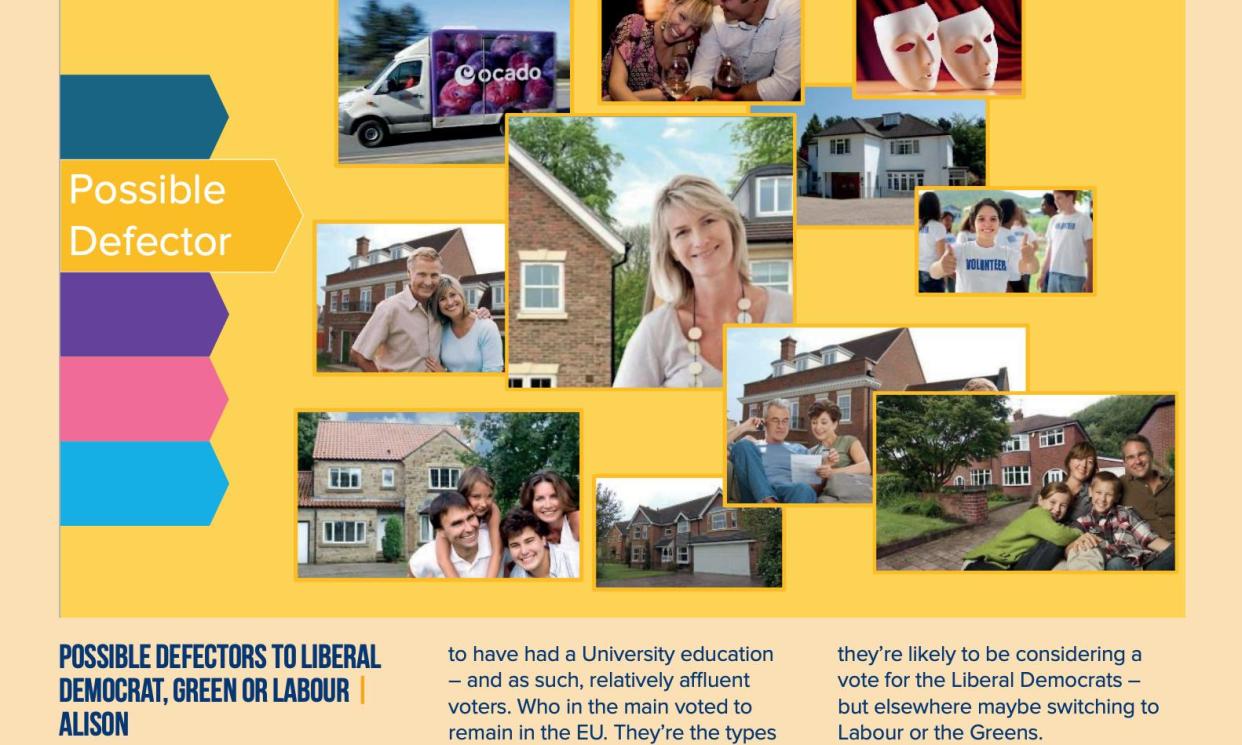Harold, Denise, Alison and Mark: Tories’ hypothetical target voters are all white, document reveals

Meet Harold, Denise, Alison and Mark: the four key target audiences identified by Conservative strategists as the right people to win them seats in the general election.
The four theoretical voters are defined as the “persuasion audience”, very likely to head to the polls and open to considering backing the Tories.
The internal document from Conservative campaign headquarters’ voter insight team, which the Guardian has seen, reveals the characteristics of those that local campaigners are being urged to focus on.
The cover of the guide, titled Targeting the Right Voters to Win Your Seat, shows a cross-section of Britain, spanning ages and ethnic backgrounds. It has arrows showing the right voters to be targeted, pointing at illustrations of Harold, Denise, Alison and Mark, all of whom are white.
Party strategists may want to reconsider the guide’s first message to campaigners. The document opens with a quote attributed to Lynton Crosby, the Australian political strategist: “Go duck hunting where the ducks are.”
Harold
Harold still uses a landline, uses the post and has a pension. These voters, party officials believe, are considering defecting from the Conservative party to Nigel Farage’s Reform UK. They are more likely to be male than female, highly likely to have voted leave and to have voted for the Brexit party in the 2019 local and European elections. One source said voters like Harold had been targeted with a survey on immigration.
Under the party’s 80:20 strategy of defending its 80 most marginal seats and targeting the 20 most vulnerable, which one Tory official told the Guardian “no longer exists”, these voters can be found in Tory-held Dudley, as well as Rother Valley, forecast to be lost to Labour, and Dagenham and Rainham, eighth on the Conservative target list.
According to the party’s assessment of its voters from 2019, nearly two-thirds of this group are considering voting for another party or don’t yet know who they will vote for.
Denise
Denise converted to the Conservatives in 2017 or 2019 and voters like her were “lifelong Labour or Liberal Democrat supporters who voted for us to support getting Brexit done and to stop Jeremy Corbyn”. Voters like Denise are described as “middle-aged or older” and “on modest incomes”.
She too can be found in Dudley, as well as Bassetlaw and the new constituency of Whitehaven and Workington, although the photographs associated with Denise include housing on the Kilburn Vale estate and the Alexandra and Ainsworth estate in Camden, north London.
A little under half of voters like Denise backed the Conservatives in 2019, but the party’s research suggests that less than 20% will definitely support them this year.
Alison
Alison likes the theatre, Ocado groceries and glasses of wine. She is middle-aged , volunteers and looks after her young children while paying off a mortgage. University-educated and a remain voter, Alison is the type of person “who won us the elections in 2010 and 2015”, especially from seats taken by the Conservatives from the Liberal Democrats.
She is considering voting for the Lib Dems again, but in other constituencies is looking at switching to Labour or the Greens. Tory strategists believe Alison can be found in Wokingham, Winchester and Guildford, target seats for the Liberal Democrats.
The guide even identifies subsections of Alison: “Alpha Families”, “Cafés and Catchments”, and “Premium Fortunes”. Premium Fortune Alisons are highly educated company directors living in expensive detached houses with myWaitrose cards. Only one out of three Alisons that backed the Tories in 2019 are considering doing so again.
Mark
Mark is a “typical soft voter”, difficult to define based on their demographics or vote in the EU referendum, strategists believe. But the documents say that “using millions of voting intentions gathered over the past few months, we’re able to match that to Experian data, and identify those people most likely to be choosing between us and Labour”. Mark is more likely to be middle-aged, with older kids that have left home and a mortgage to pay off on average incomes.
Mark lives in constituencies currently held by the Conservatives such as York Outer, Stockton West and Dominic Raab’s former seat, Esher and Walton. The party’s figures suggest just over 20% of Marks are projected to back them, but campaigners are urged to focus on the 35% of Marks that might be convinced to support the Conservatives again.
A focus on postal votes
As polling day draws closer, the strategy for campaigners will be to squeeze voters as postal ballots arrive before moving on to those more likely to vote in person, according to the document. It suggests that in “a typical Conservative held seat as many as 25% of target voters are likely to be voting by post”.
The importance of ensuring the right audiences are targeted by campaigners is explained in the guide: “If we don’t use our volunteers’ precious time and our donors’ precious money effectively, focussing our effort and expenditure on the right voters, we’ll be wasting their time and their money. Costing us votes. And costing you victory.”
A Conservative spokesperson said: “The leaflet is reflective of the wide and diverse society we live in.”

 Yahoo News
Yahoo News 
